Abstract
Between January and March 1988, an outbreak of gastroenteritis occurred among children and staff at a day-care center in Sydney, New South Wales, Australia. Over an 11-week period, 53 persons had 101 episodes of gastroenteritis; some patients had 5 separate episodes. The principal etiologic agent in the outbreak, human calicivirus (HCV), was detected by electron microscopy in 32% of fecal specimens from children and staff members with symptoms but in only 8% of asymptomatic individuals (P less than 0.01). HCV was confirmed by both an enzyme immunoassay and solid-phase immune electron microscopy. HCV infection was a particular problem in infants, who had the highest age-specific attack rates, had the greatest symptomatic/asymptomatic infection ratio, and were most likely to have a second symptomatic episode. The mode of transmission of this virus was not identified, and extensive efforts to control the 11-week outbreak had little effect. Prolonged excretion of HCV by some symptomatic patients and high rates of asymptomatic infection may have contributed to the extended duration of the outbreak. HCV may be a common cause of gastroenteritis in children that is under-recognized because of insensitive methods of detection.
Full text
PDF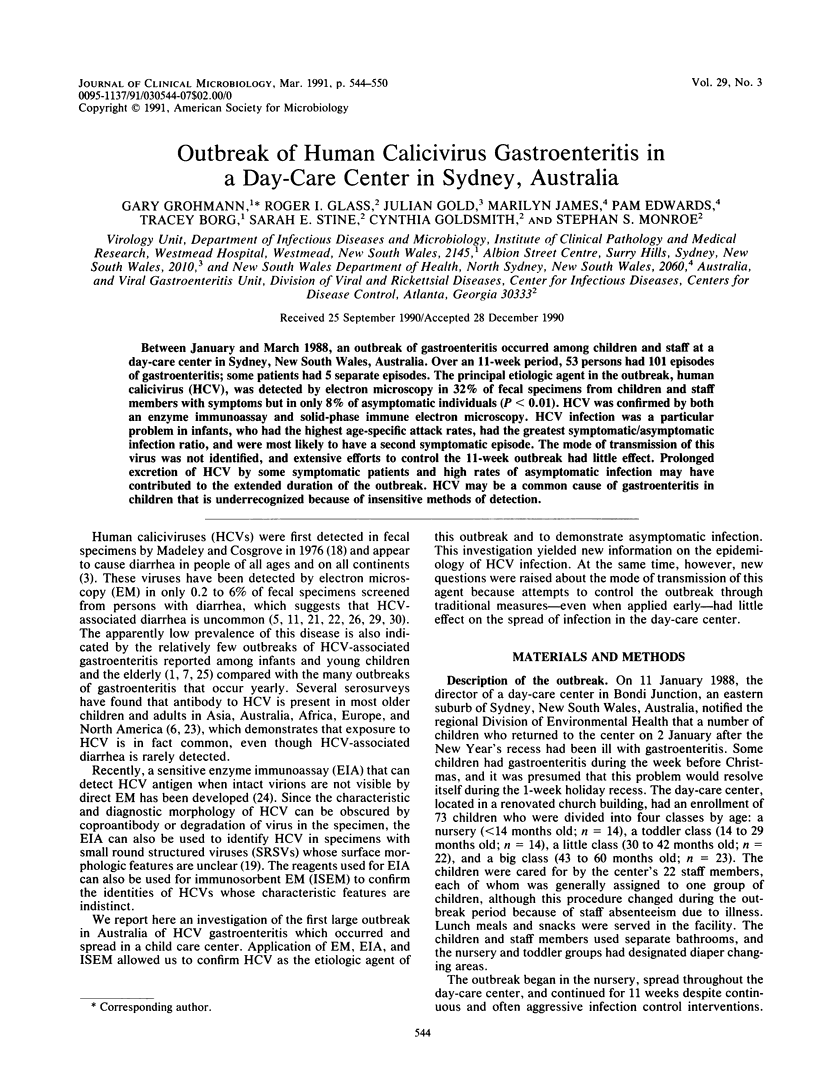
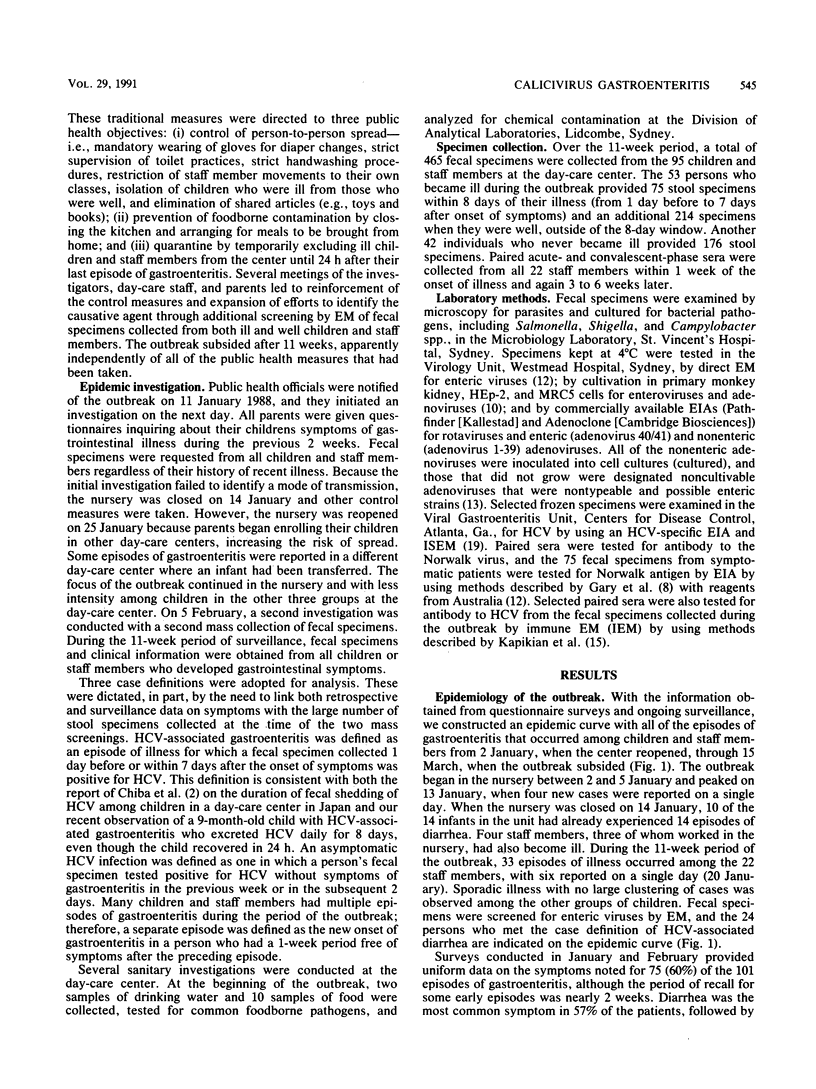
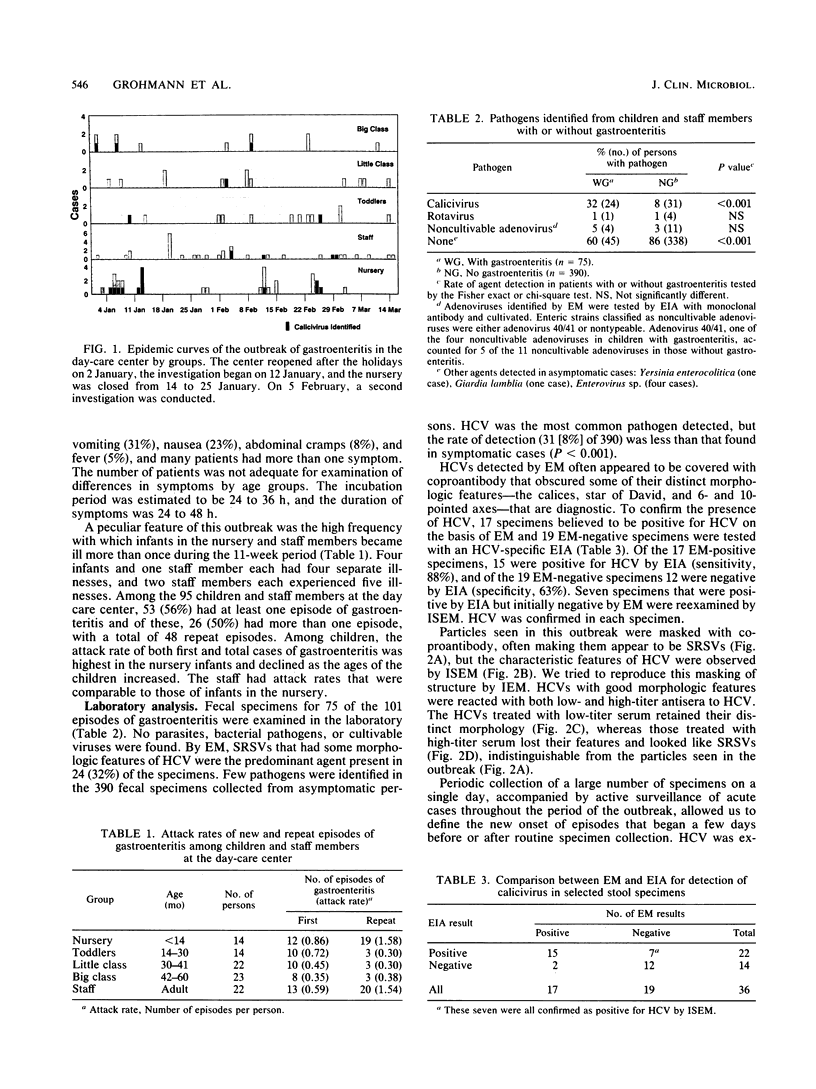
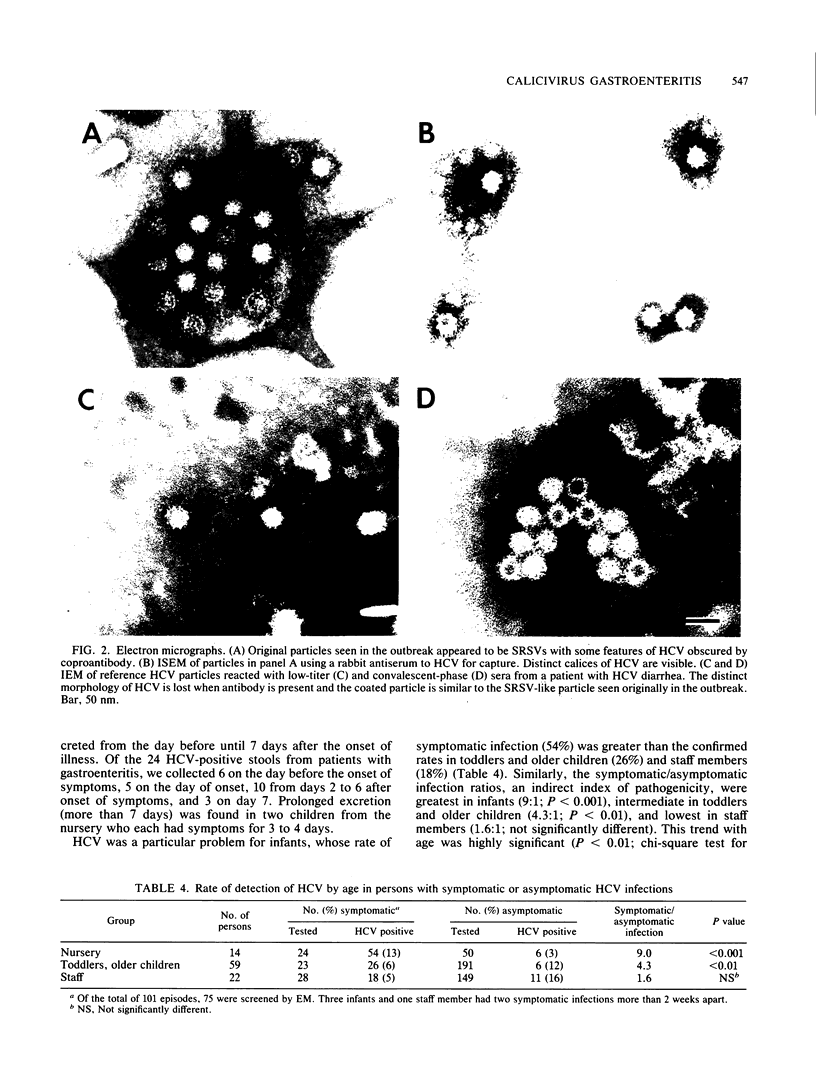
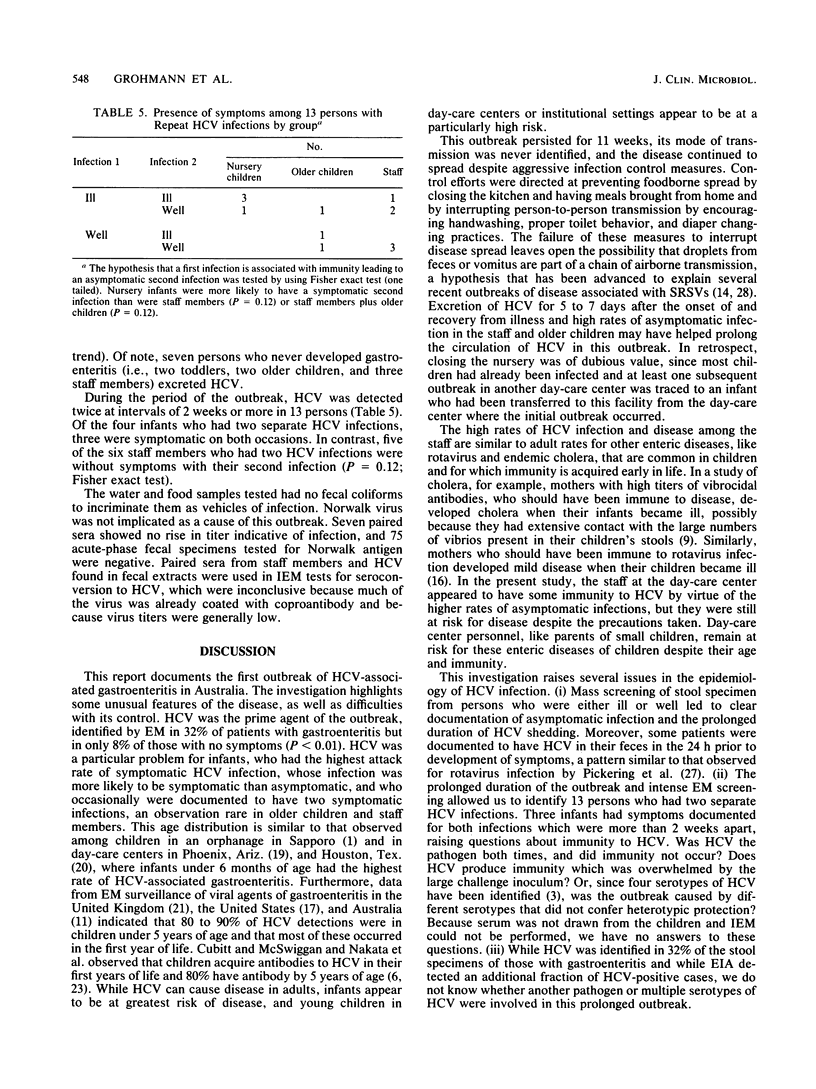
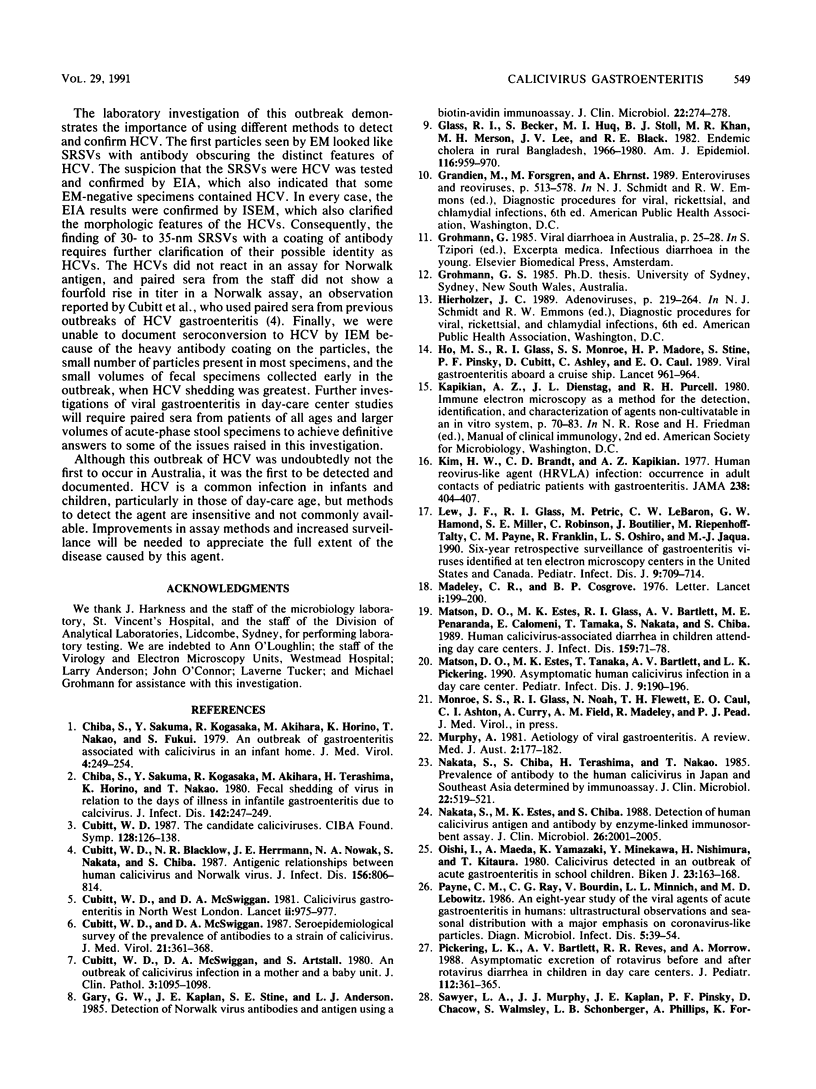
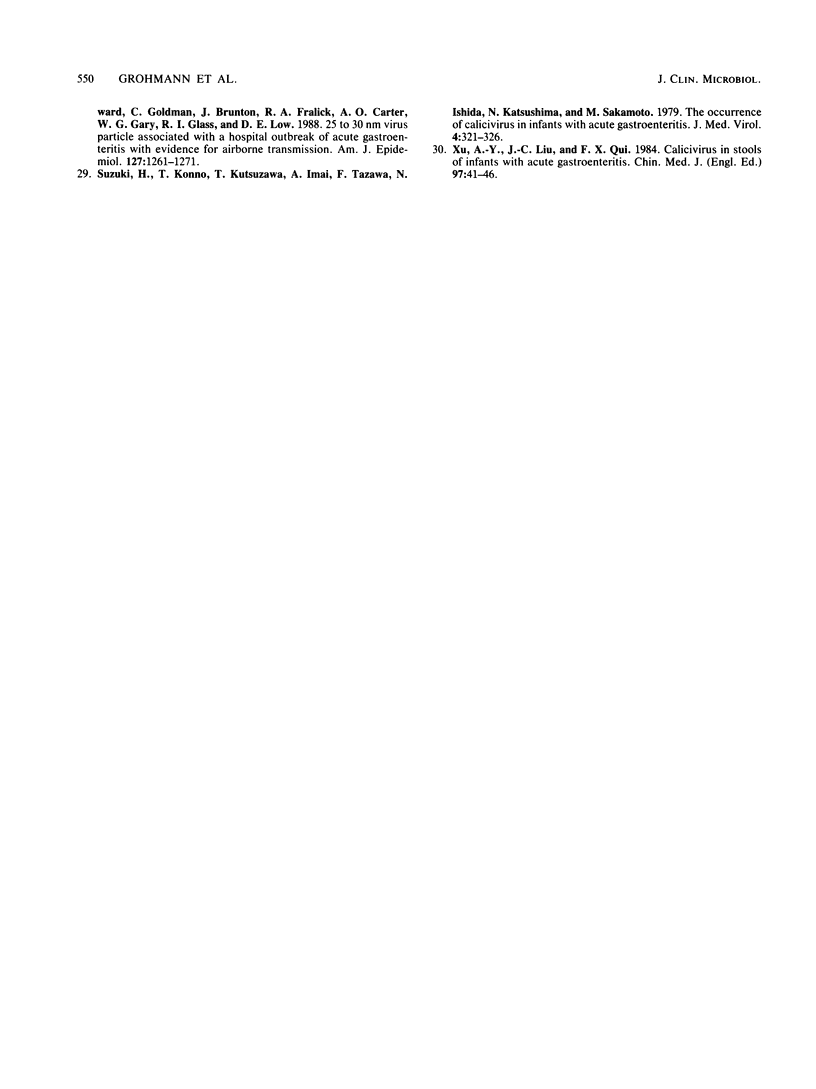
Images in this article
Selected References
These references are in PubMed. This may not be the complete list of references from this article.
- Chiba S., Sakuma Y., Kogasaka R., Akihara M., Horino K., Nakao T., Fukui S. An outbreak of gastroenteritis associated with calicivirus in an infant home. J Med Virol. 1979;4(4):249–254. doi: 10.1002/jmv.1890040402. [DOI] [PubMed] [Google Scholar]
- Chiba S., Sakuma Y., Kogasaka R., Akihara M., Terashima H., Horino K., Nakao T. Fecal shedding of virus in relation to the days of illness in infantile gastroenteritis due to calicivirus. J Infect Dis. 1980 Aug;142(2):247–249. doi: 10.1093/infdis/142.2.247. [DOI] [PubMed] [Google Scholar]
- Cubitt W. D., Blacklow N. R., Herrmann J. E., Nowak N. A., Nakata S., Chiba S. Antigenic relationships between human caliciviruses and Norwalk virus. J Infect Dis. 1987 Nov;156(5):806–814. doi: 10.1093/infdis/156.5.806. [DOI] [PubMed] [Google Scholar]
- Cubitt W. D., McSwiggan D. A., Arstall S. An outbreak of calicivirus infection in a mother and baby unit. J Clin Pathol. 1980 Nov;33(11):1095–1098. doi: 10.1136/jcp.33.11.1095. [DOI] [PMC free article] [PubMed] [Google Scholar]
- Cubitt W. D., McSwiggan D. A. Calicivirus gastroenteritis in North West London. Lancet. 1981 Oct 31;2(8253):975–977. doi: 10.1016/S0140-6736(81)91167-3. [DOI] [PMC free article] [PubMed] [Google Scholar]
- Cubitt W. D., McSwiggan D. A. Seroepidemiological survey of the prevalence of antibodies to a strain of human calicivirus. J Med Virol. 1987 Apr;21(4):361–368. doi: 10.1002/jmv.1890210408. [DOI] [PubMed] [Google Scholar]
- Cubitt W. D. The candidate caliciviruses. Ciba Found Symp. 1987;128:126–143. doi: 10.1002/9780470513460.ch8. [DOI] [PubMed] [Google Scholar]
- Gary G. W., Jr, Kaplan J. E., Stine S. E., Anderson L. J. Detection of Norwalk virus antibodies and antigen with a biotin-avidin immunoassay. J Clin Microbiol. 1985 Aug;22(2):274–278. doi: 10.1128/jcm.22.2.274-278.1985. [DOI] [PMC free article] [PubMed] [Google Scholar]
- Glass R. I., Becker S., Huq M. I., Stoll B. J., Khan M. U., Merson M. H., Lee J. V., Black R. E. Endemic cholera in rural Bangladesh, 1966-1980. Am J Epidemiol. 1982 Dec;116(6):959–970. doi: 10.1093/oxfordjournals.aje.a113498. [DOI] [PubMed] [Google Scholar]
- Ho M. S., Glass R. I., Monroe S. S., Madore H. P., Stine S., Pinsky P. F., Cubitt D., Ashley C., Caul E. O. Viral gastroenteritis aboard a cruise ship. Lancet. 1989 Oct 21;2(8669):961–965. doi: 10.1016/s0140-6736(89)90964-1. [DOI] [PubMed] [Google Scholar]
- Kim H. W., Brandt C. D., Kapikian A. Z., Wyatt R. G., Arrobio J. O., Rodriguez W. J., Chanock R. M., Parrott R. H. Human reovirus-like agent infection. Occurrence in adult contacts of pediatric patients with gastroenteritis. JAMA. 1977 Aug 1;238(5):404–407. doi: 10.1001/jama.238.5.404. [DOI] [PubMed] [Google Scholar]
- Lew J. F., Glass R. I., Petric M., Lebaron C. W., Hammond G. W., Miller S. E., Robinson C., Boutilier J., Riepenhoff-Talty M., Payne C. M. Six-year retrospective surveillance of gastroenteritis viruses identified at ten electron microscopy centers in the United States and Canada. Pediatr Infect Dis J. 1990 Oct;9(10):709–714. doi: 10.1097/00006454-199010000-00005. [DOI] [PubMed] [Google Scholar]
- Madeley C. R., Cosgrove B. P. Letter: Caliciviruses in man. Lancet. 1976 Jan 24;1(7952):199–200. doi: 10.1016/s0140-6736(76)91309-x. [DOI] [PubMed] [Google Scholar]
- Matson D. O., Estes M. K., Glass R. I., Bartlett A. V., Penaranda M., Calomeni E., Tanaka T., Nakata S., Chiba S. Human calicivirus-associated diarrhea in children attending day care centers. J Infect Dis. 1989 Jan;159(1):71–78. doi: 10.1093/infdis/159.1.71. [DOI] [PMC free article] [PubMed] [Google Scholar]
- Matson D. O., Estes M. K., Tanaka T., Bartlett A. V., Pickering L. K. Asymptomatic human calicivirus infection in a day care center. Pediatr Infect Dis J. 1990 Mar;9(3):190–196. doi: 10.1097/00006454-199003000-00009. [DOI] [PubMed] [Google Scholar]
- Murphy A. Aetiology of viral gastroenteritis: a review. Med J Aust. 1981 Aug 22;2(4):177–182. [PubMed] [Google Scholar]
- Nakata S., Chiba S., Terashima H., Nakao T. Prevalence of antibody to human calicivirus in Japan and Southeast Asia determined by radioimmunoassay. J Clin Microbiol. 1985 Oct;22(4):519–521. doi: 10.1128/jcm.22.4.519-521.1985. [DOI] [PMC free article] [PubMed] [Google Scholar]
- Nakata S., Estes M. K., Chiba S. Detection of human calicivirus antigen and antibody by enzyme-linked immunosorbent assays. J Clin Microbiol. 1988 Oct;26(10):2001–2005. doi: 10.1128/jcm.26.10.2001-2005.1988. [DOI] [PMC free article] [PubMed] [Google Scholar]
- Oishi I., Maeda A., Yamazaki K., Minekawa Y., Nishimura H., Kitaura T. Calicivirus detected in outbreaks of acute gastroenteritis in school children. Biken J. 1980 Dec;23(4):163–168. [PubMed] [Google Scholar]
- Payne C. M., Ray C. G., Borduin V., Minnich L. L., Lebowitz M. D. An eight-year study of the viral agents of acute gastroenteritis in humans: ultrastructural observations and seasonal distribution with a major emphasis on coronavirus-like particles. Diagn Microbiol Infect Dis. 1986 May;5(1):39–54. doi: 10.1016/0732-8893(86)90090-8. [DOI] [PMC free article] [PubMed] [Google Scholar]
- Pickering L. K., Bartlett A. V., 3rd, Reves R. R., Morrow A. Asymptomatic excretion of rotavirus before and after rotavirus diarrhea in children in day care centers. J Pediatr. 1988 Mar;112(3):361–365. doi: 10.1016/s0022-3476(88)80313-5. [DOI] [PubMed] [Google Scholar]
- Suzuki H., Konno T., Kutsuzawa T., Imai A., Tazawa F., Ishida N., Katsushima N., Sakamoto M. The occurrence of calicivirus in infants with acute gastroenteritis. J Med Virol. 1979;4(4):321–326. doi: 10.1002/jmv.1890040410. [DOI] [PubMed] [Google Scholar]
- Xu A. Y., Liu J. C., Qiu F. X. Calicivirus in stools of infants with acute gastroenteritis. Chin Med J (Engl) 1984 Jan;97(1):41–46. [PubMed] [Google Scholar]



